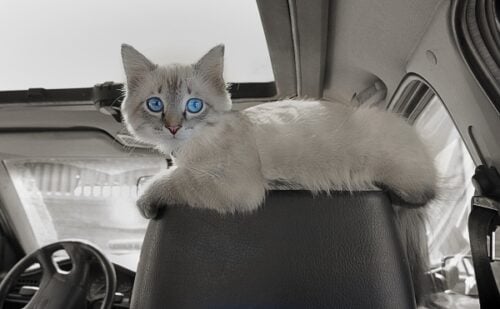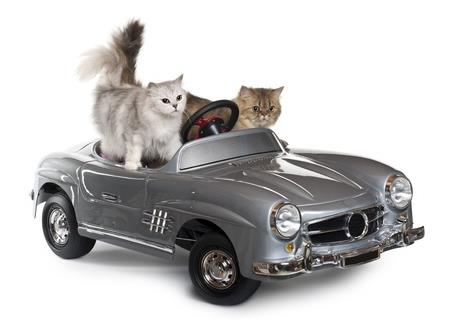Not all cats are the same when it comes to riding a car. Some get scared or violent, some get sick, and some cats are as chill as can be.
We used to take hour long rides with our cat Jersey and had no problems. But then something changed. We took her to our clinic for spaying surgery and this is where we lost her trust. She became hellishly afraid of car rides, or even just seeing her cat carrier.
In this article, you’ll learn our top tips on how to travel with a cat in a car.

Table of Contents
- How do you travel long distance with a cat in a car?
- How do you travel long distance with a cat in a car? Top 16 Tips
How do you travel long distance with a cat in a car?
After that fateful car ride to get spayed, our cat would run away and try to scratch anyone who tried getting her near the car. She vocalized in unearthly tones and released her gastro-intestinal contents through various orifices during even a short trip in her cat carrier.
Our experience with our little girl may be an extreme example. A car ride with your cat is likely to be easier than that. We have learned a great deal from our own experiences and working with patients that are cat parents that come into our veterinary clinic. First, please understand that getting your cat to love long distance travel in a car isn’t the main goal. Rather, getting your cat comfortable to travel in a car is the goal. Short trip or long distance shouldn’t matter to your cat, getting them desensitized to car travel is the key.

How do you travel long distance with a cat in a car? Top 16 Tips
If your cat isn’t comfortable here are our top 16 tips to help you.
- Always use a cat carrier. It isn’t just a convenient way to carry your cat. It’s a safety measure. It’s equal to a car seat for a child for two legged children. The use of a cat carrier may be required by law where you live. In case of accident or sudden braking, a cat carrier keeps your pet safe and secure. It also keeps your cat from wandering around the cabin of the vehicle. This is safer than perhaps distracting you the driver and the worse case happens, causing you to have an accident. Always put your cat inside a carrier during a car ride regardless of the distance traveled. The most important thing is to secure the cat carrier to the vehicle with a seat belt or secure it some other way. This way, should the worse case happen, your cat will be safer as their cat carrier won’t go flying around the inside of your vehicle.
 Choose a good cat carrier. First of all, it must be comfortable for you to carry around. Most importantly, comfortable for your cat to be in for long periods of time. Because your cat wants it larger and you want it smaller, you’ll have to compromise on the size. The final decision depends on how long you have to carry it and how long your cat must sit inside it. For long or frequent car travel, consider getting a pet crate. The largest crates can house a cat bed, food, and a litter box. A litter box may seem odd, but there are cats who will use them in a moving car. Crates are usually hard plastic which adds more protection for your four legged fur baby. Another reason we are fans of pet crates are they can be closed and secured. Having a carrier door that locks securely is key. This way you know your cat won’t get out and perhaps get lost. In an accident, this can help contain your pet in their travel carrier so they don’t get tossed around the vehicle’s interior.
Choose a good cat carrier. First of all, it must be comfortable for you to carry around. Most importantly, comfortable for your cat to be in for long periods of time. Because your cat wants it larger and you want it smaller, you’ll have to compromise on the size. The final decision depends on how long you have to carry it and how long your cat must sit inside it. For long or frequent car travel, consider getting a pet crate. The largest crates can house a cat bed, food, and a litter box. A litter box may seem odd, but there are cats who will use them in a moving car. Crates are usually hard plastic which adds more protection for your four legged fur baby. Another reason we are fans of pet crates are they can be closed and secured. Having a carrier door that locks securely is key. This way you know your cat won’t get out and perhaps get lost. In an accident, this can help contain your pet in their travel carrier so they don’t get tossed around the vehicle’s interior.- Cat carrier or pet crate. What’s the difference? A cat carrier is usually a soft sided carrier bag with vents. A pet crate is a hard plastic box that has a locking door and vents. While a cat carrier is easier to deal with as you can carrying them with the shoulder strap and are usually very light weight. A pet crate usually is carried by its handle on top. We prefer a pet crate as it offers more protection if an accident occurs. They are also lockable and offer more space for our cats to move around inside of them.
- Get your cat used to the carrier. Keep the carrier available to your cat at all times in your home. Put your cat in there without actually going to scary places like the veterinary clinic. Make it inviting by giving them cat treats to go inside, stay inside, and after being released. We actually trained our cats to go into their travel crates by putting treats in them, then giving them the command “Crate“. They would run into their crates to grab their treats. It changes the way your cat sees their travel carrier from an torture chamber that transports them to awful places to a safe box where they get treats. We also found that if you have a crate that separates into a top and bottom, you can just put out the bottom at first to get your cat used to it. Slowly add the top, then the door. At first, don’t close the door, just let your cat come and go as they please. If you use the cat carrier as a place for your cat to rest during the day, they’ll be so much happier to get inside of it for a road trip.
- Make the carrier comfy. Place a pad or blanket on the bottom of the pet carrier. Ideally one that your cat already has slept on to make them more comfortable. Place some of their favorite toys and even stuffed animals that they play with. Put as many soft things in the crate to make it just like home. The key word is soft. You don’t want something hard flying into and injuring your cat because you had to slam on the brakes unexpectedly.
- Calm your cat during the ride. How do you do that? First, don’t overdo it. Place your cat where he or she will feel more comfortable. This is of course quite personal for each cat. Some like to see where they’re going and have you the cat owner in sight. Some want to be left alone. Our little girl wanted to be where she could feel the air conditioner gently blowing on her. Crazy huh? You can place the pet carrier or crate with the opening facing you or you can put it in the rear of the vehicle (not a closed trunk!) and even cover it with a towel or blanket. If it helps, you can talk to your cat in your normal “I’m talking to my cat” voice. You can also give them tasty treats so the trip is associated with something positive, or at least their mind is distracted by eating. Playing the radio can help calm your cat down, provided they like your choice of music better than the sound of the engine. Consult with your veterinarian if you are having trouble calming your cat down. There are many things that we can offer pet owners to help with this beyond a sedative. IMPORTANT: Don’t interact with your cat when you are driving. Your undivided attention must be on the road. Under no circumstances should you let your cat out of their carrier while the car is moving. If your cat needs to be let out, pull over and park first. Safety first for both you and your cat.
- Go for short rides often. Go for short rides often. You want to get your cat used to car travel. Go on frequent, short trips. This will let them know that driving isn’t as bad as they feared. Brief moments of terror are bearable. These short excursions in the car will show that nothing bad happens during them. If you know you are going on a long distance trip in the future, start this desensitization as early as possible.
 Don’t just go to the vet. If you only drive your cat to the veterinarian, they will know what’s going to happen the next time you bring out their cat carrier. Instead, take your cat to nice places too. For a cat, a nice place is a neutral place. Take them to your friends or relatives house they’ve been to, or a natural area like a park, or just drive around the block. Of course this may sound silly. After all, cats aren’t like dogs who need to be with you wherever you go. But if taking them with you helps to relieve their fear of car rides, make it part of the desensitization training.
Don’t just go to the vet. If you only drive your cat to the veterinarian, they will know what’s going to happen the next time you bring out their cat carrier. Instead, take your cat to nice places too. For a cat, a nice place is a neutral place. Take them to your friends or relatives house they’ve been to, or a natural area like a park, or just drive around the block. Of course this may sound silly. After all, cats aren’t like dogs who need to be with you wherever you go. But if taking them with you helps to relieve their fear of car rides, make it part of the desensitization training.- Think what cat supplies you will need. What you need depends on the car ride length and its purpose. Things you should consider are cat food, fresh water, bowls, litter box, cat litter, leash, cat harness and your cat’s medicine if they are taking any. Get your cat used to these items well before your trip. If possible, bring their food and water bowls that they are used to at home. The more familiar your cat is with the items around them, the less stressed they will be. We’ve found a backpack or duffel bag works well to keep all your pet supplies in one place. Please see our tips for a travel litter box below.
- Plan enough breaks during a long car ride. Long car rides are tiresome for cats as well as people. They need to stretch, go to the toilet, get water or food, or just see something else besides the carrier’s walls. There are no fixed rules on how long breaks should be or how often you need them. A typical cat goes to the toilet every four to six hours. Some cats can hold it longer, some can’t last half that long. The general rule is, if you need a break, your cat probably needs one too.

- Secure your cat. An important safety tip is to secure your cat with a cat harness or collar and leash while inside a closed car when you stop. Put the leash on your cat before opening the car door. This way you have control of your cat when you do open the pet carrier door. If a car door is open and you open the carrier door, your cat could be get startled and bolt from the car. For example, if your cat is in their pet carrier in the cargo hold of your SUV, get inside the cargo hold, close the rear door, then open the carrier door to put the leash on your cat. Trust us on this one, we’ve heard many stories of cat’s bolting from their carriers.
- Bring a travel litter box. Ideally, getting your cat used to using it before a long road trip will be very beneficial for you and your cat. Using a travel litter box at home will allow your cat to give the cat litter in it their scent. You can put some of the cat litter from their regular litter box in it at first so your cat knows it’s theirs. Your cat will be much more comfortable using the travel litter box on the road if they are already comfortable with it at home. Our little girl actually went on a long distance road trip and didn’t poop for 2 days as she wasn’t used to her travel litter box. Thankfully she finally went. By getting her more familiar with her travel litter box, she was fine on the next trip.
- Identify your cat. Anything can happen on a long trip on the road. Cats can not only run away during a stop, they can also get lost after a crash or theft. An ID tag with your cell phone number is the quickest way you can be reunited with your cat if someone finds them. Even better, having a microchip ensures that if their collar is lost, your cat can be returned if they end up in a shelter or veterinary clinic. We strongly recommend that every pet have a microchip implanted. It’s an easy procedure that we do frequently in our veterinary clinic. Secure emergency contact information on the top of the travel carrier. This should include your personal information as well as emergency contact information. You should also have a photo of your cat printed out with you just in case. Of course you have a billion pics of them on your phone, having one printed out that you can give to people to help you find your pet is a good idea.
- One pet per carrier. As a pet parent, you likely have more than one four legged fur baby. If you are a cat lover, you likely have multiple cats. If so, put each kitty in their own carrier or crate on a car trip. While your cats may love to snuggle, for their own safety and yours, keeping them separate while in their cats carrier is important. The reason for this is, imagine driving down the freeway at a high rate of speed and your two cats that are in the same carrier decide it’s time to have an epic battle. It’ll startle you and potentially cause you to have an accident. A car traveling at 65 miles per hour moves 100 feet per second. If you get distracted by the cat behavior behind you for even a second, your vehicle traveled 100 feet. Worse, in an accident both of your cats could impact each other causing worse injuries than if they were alone.
- No hot cars. Never leave your pet in your car for any length of time in hot weather. If it’s sunny out and it’s warm, the interior or your car will get much hotter. A study found that if it’s 95 F outside, after an hour, your car would reach 116 F inside. When you have to stop, try to find some shade to keep your car from getting too hot. Open the windows and let the breeze help keep things more comfortable. Our feline friends are covered in fur and can overheat quickly.
- Call hotels ahead of time. Not surprisingly, many hotels have no pet policies. Save yourself some time and stress by contacting the hotels you plan to stay at during your long distance road trip. Many hotels may add an extra fee if they know you are staying with a pet so factor that into your planning too.
This is a list of the top tips for driving with your feline friend. You’ll learn more as you get more experience taking your cat on road trips. As the saying goes, you only learn to take your cat on a car ride once you do it.
Just remember, even though many cats adapt to driving, yours may not find life on the road pure joy. And, unlike dogs who love their owners wherever they are, cats prefer to be stay at home pets.
Thus, if you are going on a vacation, it might be better for your cat to remain at home and to have someone check on them regularly.
Now that you know the top 16 tips for how to travel with a cat in a car, you can take your cat with you on your adventures. This will go a long way towards a happy life for you and your pet cat. And keeping your Pet Happy is what we all want.
